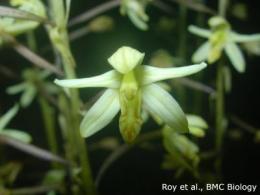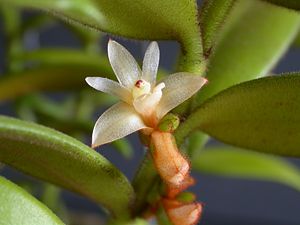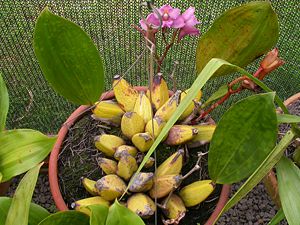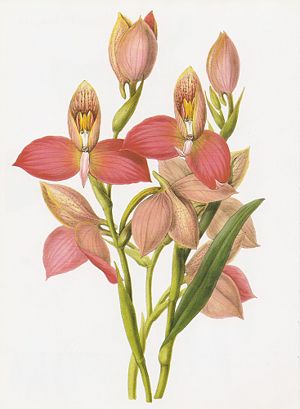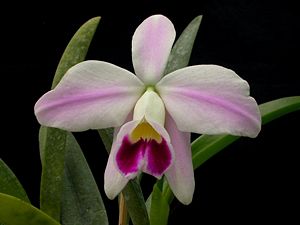Orchid
| Orchidaceae | ||||||||||||
|---|---|---|---|---|---|---|---|---|---|---|---|---|
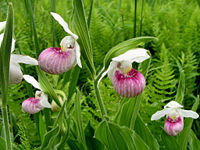 Cypripedium reginae
| ||||||||||||
| Scientific classification | ||||||||||||
| ||||||||||||
| Type genus | ||||||||||||
| Orchis L. 1753 | ||||||||||||
| Subfamilies | ||||||||||||
| ||||||||||||
| Synonyms | ||||||||||||
|
Orchids belong to one of the two largest families of flowering plants, the Orchidaceae. This family comprises about 1,000 genera and more than 15,000 species. They are botanically considered herbs, since they do not produce wood. Although many of the most exotic species are epiphytes, many orchids are also terrestrial and saprophytic.
Orchids have been cultivated for centuries. They include rare and recent discoveries such as the tiny Genoplesium plumosum, the large, showy orchids, which are featured in bouquets and corsages, and 'food' orchids such as Vanilla. A few orchids have insignificant flowers and are grown for their foliage.
Epiphytic orchids do not root in soil, and assimilate all their water and nutrients from air and rain. Some species store water in thickened, succulent stems, called pseudobulbs, others have highly porous roots covered by a spongy layer that can absorb humidity from the air. Some species go through long periods of rest when their metabolism is slowed, followed by rapid growth when resources are abundant. Many species lose their leaves to avoid dehydration during droughts, or while they are resting.[1]
Orchids seem to attract a universal fascination, with orchid societies in every developed nation. Although highly prized for their often bizarre shapes and striking nature, the fascination of orchids extends beyond their form and beauty. Orchids are remarkable examples of speciation through natural selection. Some orchids have developed extraordinary systems of pollination. The Lady's Slipper, for instance, traps insects and forces them to pollinate the flower. An Australian orchid thrives underground and is pollinated by ants.
Distribution
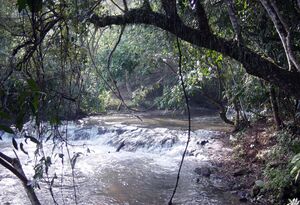
The Feijão River, near Itirapina in São Paulo State, Brazil.
This jungle exemplifies the perfect conditions for orchids to thrive. Though cloudy mountain forests and tropical forests host around three quarters of orchid species, they can also be found in many other environments.
Owing to a remarkable range of highly specialised adaptations to suit very different climates and very different pollinator species, orchids naturally occur in almost all regions of the planet, except in Antarctica[2] The number of orchid genera on each continent cannot be given exactly because taxonomists disagree about details of their classification, but Eurasia has about 50 genera; North America, about 25; Latin America and Caribbean, between 300 and 350; tropical Asia, between 250 and 300; tropical Africa, about 250; and Oceania, about 60.[3]
The greatest diversity of orchid species occurs in tropical areas, notably in mountainous areas, due to the effect of reproductive isolation of plant species caused by the mountains. Islands generally provide favourable conditions for speciation but unless they are large enough to have a variety of climates, they tend to have just a few endemic species. Such unusually large islands include Borneo, New Guinea, and Madagascar, all of which exhibit a wealth of different species, many unique to their respective island. Due to these factors, the main areas noted for having a large number of orchid species include the islands of Southeast Asia, the mountainous areas of Ecuador and Colombia and the Atlantic Jungle along the Brazilian coastal mountains, where more than fifteen hundred species have been catalogued.[4] Other important areas with considerable orchid diversity are the mountains of Mesoamerica, the peaks south of Himalaya in India and China, and the southeast of Africa, particularly Madagascar.
The three countries with the largest number of reported orchid species are Ecuador, with over 3,500. [5] Colombia, with over 2,700, [5] and Brazil, with over 2,500.[5] Other orchid-rich places include New Guinea, which as a whole has over 2,700 species, Borneo, Sumatra, Madagascar, Venezuela and Costa Rica[6]
Habitat
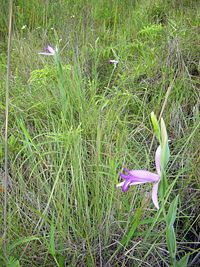
Cleistes libonii, habitat.
Some terrestrial orchids live in grass fields and clearings in or next to forests. Most of these species need more light than typical orchids, and are difficult to see when not in bloom. They frequently have long inflorescences so pollinators their flowers can be seen over the grass by .
Orchids have evolved to fit many widely different environments. Some are terrestrial, growing on grass fields and savannahs among the grass, or on the soil of shady forests; some are epiphytic, growing over trees or bushes, close to the soil and sheltered from bright sunlight, or close to the tops of their hosts, exposed to strong sunlight; some are lithophytes, growing over rocky soil or directly on the stones, some are psamophytics and live on sandy beaches, some are myco-heterotrophs that live in association with fungi, a few species are achlorophyllous holoparasites, or, rarely, paludicolous, in marshes and swamp areas. In Australia, there is even one buried species, from which only the flowers occasionally emerge, straight from the soil.[7]
The most common orchids in each of these areas are highly variable. In tropical regions, where humidity is high but competition for light is intense, most orchids are epiphytical, but there are also many terrestrial species, able to thrive without much light.[1] The epiphytical orchid species, looking for light underneath the shadow of trees up to forty meters tall, grow over their host's branches and stems at diverse heights according to the their specific light needs. Their roots, exposed to the air, obtain most of their nutrients from three sources: decaying material that accumulates around them, rain that washes the tree leaves from above, and finally, simply from the dust in the air. Orchid roots are covered by a spongy tissue called vellamen. Associated with the vellamen, most orchids form a mycorrhiza with a fungus that helps them by decomposing organic material into mineral salts which are easier for the orchids to absorb. In extreme conditions, orchids may absorb water and nutrients through the pores on their leaves, leaving to the roots only the function of keeping them in one place. No orchid is a parasite of other plants, so their presence never damages their hosts, although, in exceptional cases, some tree branches may not be strong enough to sustain the weight of a large colony and may break. There are many terrestrial orchids in tropical areas too, and in contrast to the ones from temperate regions, many of them grow almost constantly during most of the year.[1] The great amount of organic material available on forest soil favors the occurrence of a few myco-heterotrophs orchid species which lack chlorophyll and obtain all their nutrients from the byproducts of associated fungal decomposition. All epiphytic orchids are myco-heterotrophic during their germination and seedling periods and many adult plants continue to obtain nutrients from their mycorrhizal fungi.
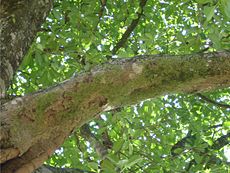
Barbosella growing over a fig tree.
Some species of orchids are so tiny that they can easily be mistaken for moss.
In cold regions where grass fields are common, or in dryer and rockier areas with small bushes, orchids are basically terrestrial plants with buried rhizomes or roots which sometimes develop into tubers enabling them to resist winter snows, droughts and occasional fires.[8] The snow might freeze epiphytic species, as they lack sheltered roots to store the nutrients required for shooting in springtime. Epiphytic species are also vulnerable to severe damage by fires. In areas with a seasonal climate, the plants normally have a distinct period of dormancy in which their aerial segments often die to avoid damage by extreme drought or cold.
Some species are in danger of extinction in the wild, due to extensive collection, loss of habitat by agriculture, and even the defoliating agents used for chemical warfare in the past.[9] Perhaps surprisingly, most endangered species are among the most commonly cultivated.[10] Most rare species are not on lists of endangered species because they have no commercial value and otherwise receive little attention because of their tiny flowers or difficulties with their culture. Governments rarely sponsor systematic surveys about wild populations, and the few such reports that exist have been compiled by private or academic researchers. [11]
Growth and blooming habits
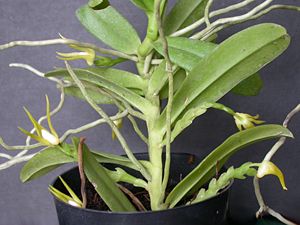
Thrixpermum centipeda.
This monopodial species is a good example of what can be an orchid of aerial growth: some of its roots get attached to the tree but most of them just hang from the branches. They are covered by a white spongy tissue (the vellamen) which is responsible for absorbing humidity from the air and storing rain water. This species also bears special evergreen inflorescences used for blooming over several years.
Orchids grow in several different ways. Some species grow continuously, more or less constantly all year, while some others have seasonal periods of growth and rest. Some species are sympodial, when a new scion sprouts from the base of a previous one; in this case, the old scion is fully developed and will not grow any further. Other species are monopodial, and grow continuously upwards, shooting new leaves from a central stem. In some cases, (as in Scaphyglottis and some Pleurothallidinae genera) they grow both from the base and from the top of older pseudobulbs. Some orchids form tight specimen plants, others are very spaced, e.g. some Rodriguezia species which have their pseudobulbs sometimes spaced for fifty centimeters. Vanilla species may have stems up to twelve meters with spaced leaves climbing over the trees. Some always grow upwards, others show pendent habits and grow downwards, hanging in the air from the branches of the trees.[12] In tropical areas, continuous growth is more common, although there are also many tropical species with seasonal growth. In areas subject to droughts or intense cold, seasonal growth is the rule. Monopodial orchids usually grow continuously, whereas sympodial orchids are usually seasonal to some degree.[1]
Orchids have very varied blooming habits. Most species just bloom once a year, in a particular season, but there are many exceptions to this rule. Flickingeria species may bloom many times a year, usually on a warm day a few days after a cold rain. Other species (as in some Epidendrum and Paphiopedilum) bloom continuously for months. Disa species may need fires, and some Coelogyne, need cold, to start blooming, and years may pass before they bloom. Many Dracula species bloom randomly anytime of the year.
Morphology
Few of the characteristics that distinguish Orchidaceae are shared by all its species. Some groups of orchids diverged from the original common ancestors very early in the evolutionary history of orchids, possibly during their first evolutionary steps, and have retained many of their qualities, while others diverged much later. As the orchids have shown an enormous range of adaptations, this has led to a vast number of variations and species.[13]
All orchids share, to different degrees, several characteristics that are uncommon in most other plant families, although for each of these characteristics, there are abundant examples of orchids without them. However, all orchids have at least some of the following characteristics [2]
- A column, a structure originated from the fusion of the flowers male and female sexual organs;
- Pollinia: pollen aggregated into cartilaginous structures;
- Very small seeds, with no endospern, which often germinate in the presence of certain fungi;
- Flowers of lateral symmetry, not radial, composed by six segments, three external sepals, and three internal petals. Of the petals, one (the labellum) is different, it is normally responsible for attracting pollinators to the column, and it plays an active role in pollination .
- Flowers usually are presented inverted from their natural position due to a process known as resupination, in which, during the bud growth, the ovaries twist by about 180°;
- In most epiphytic species, the roots are covered by a spongy tissue called vellamen;
- Orchids grow indefinitely, continuously or during short annual periods, in theory for an unlimited time. The oldest specimen under culture at the Royal Botanic Garden is more than two hundred years old. A Microlaelia lundii that belongs to the Círculo Americanense de Orquidófilos has been cultivated for more than one hundred years.
Roots: Orchids exhibit the root stricture of monocotyledonous plants and have no 'primary roots' (main central roots from which secondary roots grow), but only 'secondary roots', which start directly from the stem or from other secondary roots. Often the roots store nutrients and water, helping to retain nutritional substances that deposit on their bases. In some cases, the roots have chlorophyll organs that can sustain photosynthesis when the plants lose their leaves. The roots vary in thickness, from very thin to very thick. Root structure varies considerably among orchid genera, depending on how and where they grow.[12]
Epiphytic species generally have robust roots that are cylindrical when aerial and which become flatter after attachment to the substrate. They are often covered by the vellamen, a thick spongy tissue that helps orchids to quickly absorb water from rainfall, and even humidity from the air. Some species, particularly those of the subtribus Catasetiinae, behave as if they were pneumatophorous, with many thin roots growing up forming a sort of 'wig' that catches leaves and sediments that are shed from above during the rains.[13]
Many terrestrial species have some roots that are thickened into structures that resemble tubers. These may be spherical or elongated cylinders, and they store water and nutrients, replacing the role of pseudobulbs in epiphytic species. Occasionally, these tubers split from the mother plant, giving rise to new plants. Some Australian species of the subtribus Caladeniinae have almost no roots, only a small ovoid tuber. At the other extreme, the tubers of the Brazilian Cleistes are thin and delicate, measuring more than one meter, spreading in several directions. Collecting this species is almost impossible, for their tubers break easily, causing the plant to die.[13] As in the Cypripedium species, terrestrial orchids can have extensive underground rhizomes that vernalize and produce new growth in the following year [14].
The root's life time varies according to environmental conditions, and generally is less than the stem life time. New roots usually shoot during or at the end of each vegetative growth period. Although not the primary nutritional source of orchids, they usually benefit from a kind of symbiosis with a fungus (Mycorrhiza) that is lodged on the vellamen exterior cells of their roots, and which excretes nutrients that are absorbed directly by the roots.[13]

Cyrtopodium gigas, plant with flowers.
Some orchid species are comparatively huge. This species may be taller than a man and can be confused with a palm tree when found without flowers in the sandy areas around the low altitude jungles and the beaches along the coast.
Stems: On epiphytic species of sympodial growth the stem usually is formed by two segments. One of these segments, the rhyzome, shows reptant growth, which means it grows along the substrate. Some terrestrial orchids also have a rhyzome. The other segment is aerial, and may or may not be thickened into a structure called a pseudobulb which stores water and nutrients.
When the rhyzome is short, the orchids have a very dense appearance. This type of growth, called cespitous growth is very common in orchids, and orchids of the genus Bifrenaria always present this type of growth. When the rhizome is more elongated, the plants assume more of a climber and somewhat messy appearance; when the rhizome is ascending, the rhyzome sometimes spaces their pseudobulbs by more than half a meter. Acacallis and Rodriguezia are examples of this sort of ascending growth. When the rhizome is more malleable the orchids usually become pending, as in Loefgrenianthus. In some species of Pleurothallidinae, particularly in the group Acianthera prolifera, the rhyzome is very thick; these species do not have pseudobulbs, but instead have a thin stem called a 'ramicaul' which cannot retain water well, so the rhyzome takes over this role.
The aerial segment of the stem, the pseudobulb, is a very characteristic feature of orchids, and experienced growers can recognize most genera from its shape and size. Pseudobulbs are very variable; they may be fat and as large as a papaya, as in some Gramatophyllum species, or thin and long as sugarcane, as in some Epidendrum. They may bear one leaf, as in many Cattleya, or tens of leaves, as in some Dendrobium. Some Bulbophyllum have small pseudobulbs the size and shape of rice grains, while those of Psychopsiella are flattened as though someone has stepped on them. Some large Bifrenaria look just like a bunch of bananas. Pseudobulbs also vary in color, and can even be hidden among the leaves.
In some epiphytic genera, particularly those related to the genus Huntleya, the secondary, or aerial stem, is an inconspicuous node from which the leaves grow. Sympodial orchids usually show seasonal growth and new secondary stems are added at each period.[15]
In epiphytic species of monopodial growth, the stem is formed by the aerial segment only. It may be erect or pendent, and its extremity grows continuously forming new leaves and occasional lateral roots or new growths along the stem. The stem of this kind of orchid is never thickened into pseudobulbs, but their leaves and roots are usually thicker than those of other epiphytic orchids, as they often store water and nutrients.[12]
Terrestrial species may or may not have developed stems and, unlike epiphytic orchids which always have perennial stems, these may be partially or entirely deciduous. In these cases they are usually not true stems but pseudostems formed by the leaves. Some terrestrial orchids of genus Epistephium and Selenipedium have very long stems, sometimes more than six meters long; there are the tallest orchids that exist.[12] Some temperate terrestrial species have extensive underground stems, rhizomes that store large amounts of starch for the next years growth[16].
Leaves: Most orchids have leaves of longitudinal parallel venation with hardly visible crossings. They are usually arranged in two alternated opposed rows, on both sides of the stem. Many species have only one pseudo-terminal leaf and one aborted growth. Their shape, thickness, quantity, color, size and how they grow is highly variable.[12] Their blades can be circular, elliptical, lanceolated, oval, linear, oblong, or spatulated, with endless intermediate forms. The apex of the leaves may be rounded, accuminated, acute, thin or thick, pointed, radial, or uneven. Their edges are ordinarily smooth, partially curved, and hardly ever denticulated. The structure of the leaves may or may not show a petiole, with a variable number of longitudinal parallel nerves, which may be very visible (as in many Coeogyne and Stanhopea species), or almost imperceptible. The leaves may be very thin and malleable (as in Stigmatosema ), or fleshy, firm and breakable (as in Cattleya), or entirely succulent (as in Leptotes ). Ordinarily bearing the most diverse shades of green, the leaves may also have completely different colors on their different faces, from red to dark brown, gray tones, blueish, whitish or yellowish. Some species have stained, striped or doted leaves with several different colors. Generally the leaves are glossy, occasionally they may have a dull appearance or even look like if recovered by white dust (as in Euchile) or completely hairy (as in all species of Trichotosia).
Some species lack chlorophyll. Most species keep their leaves during some years, but some lose them immediately after their seasonal growth period and when environmental conditions are adverse. Some genera, like some Campylocentrum species, whose leaves are just rudimentary, seem to have only roots and eventual flowers. In these cases, the roots usually have chlorophyll and are responsible for photosyntheses.[13]

Stanhopea lietzei, inflorescence.
The inflorescences of orchids are highly variable. Inflorescences of genus Stanhopea grow through the substrate towards the bottom of the pot, therefore they must be potted in some sort of opens vase that allows them to go through.
Inflorescence: Orchids inflorescences, according to the species, may have from one to some hundred flowers. They may be apical, lateral or basal, racemose or paniculated, forming branches, corymbes or umbrellas, erect, arching or pending, with simultaneous or successive flowers, which can grow along the inflorescence or always from the same spot. Some species show perennial structures that are a sort of modified stem used only for blooming during several years, as happens with some species of Masdevallia and all species of Psychopsis. The flowers generally have bracts at their bases. The bracts vary greatly in size: they are often highly reduced, but may also be very large, they may seem to be part of the flower, as in some Cyrtopodium and sometimes are even bigger and more attractive than the flowers, which remain partially hidden by them, as in some Eria. The inflorescence from genus Dimorphorchis may be five meters long, with two different kinds of flowers spaced almost one meter each. Octomeria inflorescences just measure a couple of millimeters. The inflorescence of some orchid species grow down, so when these are cultivated, they appear through the holes at the bottom of the pot.[12]
Flowers: Of all plant families, orchids possibly have the widest spectrum of floral variation. Generally they have hermaphrodite flowers, but some genera in subtribus Catasetiinae may have exclusively male and female flowers, and occasionally a third type that is hermaphrodite to varying degrees, sometimes resembling male flowers, sometimes female. Interestingly when these genera with dimorphic flowers produce hermaphrodite flowers, although they are fertile, they have no natural pollinator.[12]
The size of their flowers varies from one millimeter up to twenty centimeters, or even twice that if the calcar of some orchid flowers is included. Their colors range from almost translucent to white, greenish shades, pale pink or bluish to very vibrant colors as yellow, orange, red and dark purple, and many are multicolored.[12]
The flowers normally show bilateral symmetry, with six tepals in two layers: three external sepals and three internal petals. Both the sepals and the petals are highly variable in shape and size, and occasionally are partially or completely fused. One of the petals, the labellum, (or "lip"), is always differentiated; normally expanded (but sometimes smaller than the other segments), it may be very simple resembling one of the petals, or may have calli, keels oe warts, highly variable and complicated shapes with diverse and contrasting colors. In many genera, the labellum has a hollow tubular appendix at the base (a "calcar"), or a nectary close to the area where it is hinged or attached to the column. Observing the structures and patterns of the labellum is one of the most simple ways to recognize each orchid species.[12]
Their reproductive organs, (androceu and gineceu), are reduced and fused into a single central structure called a column, gymnostem or androstyle. The number of estamen varies among the subfamilies: Apostasioideae has two or three; Cypripedioideae has two, with the central estamen modified; in the other subfamilies just the central stamen is functional, and the two others are atrophied or absent. Observing the characteristics of the column is important to correctly identify a particular species.[12]
The pollen grains are usually compressed into waxy pellets called pollinia, but may be grouped in mealy or paste-like doughs, or, (very rarely) may be loose. The pollinia are hinged by a thin connective rod structure called a caudicle or stipe, according to its morphology, it is attached to a viscous disc called a viscidium, held in place by a thick liquid produced by the rostellum. In most epiphytic species, a little helmet protects the pollinia (the "anther cap"). The stigma normally is a cavity located at the column, partially filled with the same thick liquid the rostellum produces, where the pollinia are inserted by the pollinator when it visits the flower. The ovarium usually has three chambers and holds about one million eggs.[12]
Fruit: Almost all orchid have capsular fruits, that differ in shape, size and color. The epiphytes bear much thicker fruits with fleshy walls than terrestrial species whose fruits are thinner with more delicate walls. Generally they are triangular, somewhat or highly rounded, with a variable number of keels, (between three and nine). Some are smooth, other are wrinkly or covered with warts and protuberances all over their surfaces. The fruits result from the thickening of the ovaries located at the base of the flowers, which is also usually formed by three chambers. When ripe, the fruit opens in three or six windows, or almost entirely along its length, although always remaining attached to the inflorescence. Most of the seeds soon fall among the roots of the mother plant, the rest are carried by the wind, sometimes for long distances. [12]
Seeds: Almost all orchids have tiny, light seeds, often with a single seed coat of numerous cells derived from the integuments. Each plant produces hundreds of thousands of seeds in every fruit. Unlike most plants, which generally produce endosperm that nourishes the embryo during its initial development, orchids use a symbiotic relationship with a fungal mycorrhiza, which supplies the nutrients necessary to nourish the developing seedling. Once the embryo can photosynthise, the mycorrhiza is no longer needed. Some species of myco-heterotrophs orchids will never be capable of adequate photosynthesis and remain dependent upon this fungus throughout their lives. As always with orchids, there are exceptions: some species of orchids, such as Bletilla, do produce some endosperm, and a few orchid species have comparatively large seeds (mostly members of the subfamily Vanilloideae).[13]
Taxonomy

The English botanist John Lindley is highly noted for his work describing and classifying thousands of species and genera of almost every botanic family. He is one of the most relevant orchid taxonomists of all times.
Orchidaceae is one of the largest, if not the largest, family of all plant families.[3] There are nearly 25 thousand accepted species - about eight percent of all seed plants[6] four times as many as there are mammal species and twice as many as there are species of birds.[17] These impressive numbers do not take into account the huge number of new hybrids and varieties produced by orchid growers every year. Even today, hundreds of new species are described yearly, both because of revisions of long established genera whose species were not well determined, and also due to new species discovered in nature. In 2008 alone, the International Plant Names Index registered more than four hundred new descriptions.
The orchid family was established when Antoine Laurent de Jussieu published his Genera Plantarum, in 1789.[18] However, even before Jussieu's classification, Linnaeus had described eight orchid genera which, nevertheless, did not form a family. At that time, all epiphytic species belonged to the genus Epidendrum.[19] Another genus described by Linnaeus was Orchis, a Greek name referring to the shape of two small tubers that the species of this genus show, which resemble testicles.[20] As this was the first orchid genus to be formally described, from it derived the name of the whole family.[18]
Since Orchidaceae was proposed, research on its species has progressed without interruption. Their classification has passed through numerous revisions, and the amount of known genera they are divided has increased throughout the years, now reaching more than eight hundred.[21] No exact number can be given, because there is no consensus about the best way of splitting the genera. According to each reference, the list of accepted genera are diverse and the total number differs considerably. A good example is comparing the number of genera published since 2002 to classify species before subordinated to genus Dendrobium, about thirty,[22] and the number of these which are accepted by the database of the Royal Botanic Garden, three or four.[6] The most recent trend is the classification based upon genetic, or molecular information called molecular phylogeny, which in theory reflects the evolutionary relations between species, groups of species, genera, and so forth. However, this system is comparatively new and not all taxonomists fully accept it; many still base their conclusions mostly on morphological diagnosis. The debate is lively on both fronts. One of the defenders of phylogenetics is Mark Chase, who places morphology on a secondary level,[23] Among the morphologists one of the most noted is Carlyle August Luer, who since 1978 dedicated himself to study the species of the subtribe Pleurothallidinae and thinks that phylogenetics should be regarded only as an extra tool for now.[24] Luer has described about three thousand new species of orchids.
The study of orchids has attracted several noted botanists and taxonomists through the ages. Possibly the first important figure is the English botanist John Lindley, who described thousands of species and hundreds of new genera still accepted today, however, not denying his importance, almost every orchid was new at his time. After Lindley, two Germans — Heinrich Gustav Reichenbach and Rudolf Schlechter — also described thousands of species. Schlechter was responsible for the first systematic classification of orchids, used till few decades ago. Of living botanists, possibly the most notable are two Americans: Robert Dressler who guessed most of relationships among orchids, later confirmed by phylogeny, and also established the bases of the orchid classification used today, and at last, Carlyle Luer, mentioned above.

Cattleya × mesquitae.
This ancient natural hybrid is at the edge of becoming a species. It raises the question of when a natural hybrid can be considered a species by its own merit. One of its original parents has vanished from the areas where it used to exist, and the wild plants, which resulted from countless generations of crossings among themselves, have developed a fragrance that the ones artificially produced do not share.
Orchidaceae is a family in active evolutionary development. By the traditional definition, a species comprises individuals that can breed and produce fertile descendants. Orchid species do not fit well in this concept. Not only can most species interbreed with several others to produce fertile descendants, most of the genera that belong to the same subtribe can do too.[25] Thus hybrids between different species and genera are often encountered in the wild, and almost all are fertile; they are not more common because, as orchids are highly adapted to their pollinator, the particular morphology of the hybrids may not be well adapted to the existing pollinators. There are some rare exceptions when hybrids result from two closely related species, and still can be pollinated by the same pollinators of parent species. When this happens, it is likely that in time a new species will appear. This may be the case of Cattleya × mesquitae mdash; a natural hybrid discovered in 1996 in Goiás State in Brazil that is a result of interbreeding between Cattleya walkeriana and Cattleya nobilior. It is pollinated by the same agents as its parents; crossing has occurred again and again between the three species from the area along the ages, thus one of the original parents cannot be found there anymore. All original plants have crossed and faded. Today we know that Cattleya × mesquitae is a hybrid because similar plants have been produced by artificial breeding. Lou Menezes, its describer, claims that this species is so ancient that they have even evolved in nature, developing a fragrance that is not present on the artificially produced hybrids .[26] This is one way a new species can appear in the wild. Cases like this are not uncommon among orchids, so many species are hard to distinguish precisely, because they are the result of interbreeding between closely related species. Furthermore, orchid hybrids produce variable descendants that are sometimes closer to one of the parents and sometimes are an intermediate mixture of both.[1] It is also possible that many species described by botanists may eventually turn out to be natural hybrids long established in nature.[1]
The definition of each species is sometimes even more complicated; many isolated groups show subtle differences that some taxonomists think are enough to regard them as different species, while others regard them as natural variations of populations that have been separated for long time but have not yet diverged enough to justify the establishment of another species.[11] Therefore there is no general agreement about the exact number of orchid species. Today many taxonomists would rather classify these groups of species as 'superspecies' or 'complexes of cryptic species'. In these cases the differences between the extreme variations of a group are clear, but there are so many intermediate forms that placing exact limits between several species is almost impossible. There are many examples of these groups: Brasiliorchis picta, Anacheilium vespa, Heterotaxis crassifolia, and many others.
The orchid family is formed by five subfamilies:
- Apostasioideae Reichenbach
- Plants with mealy or paste-like pollen, which ordinarily are not aggregated into pellets, called pollinia, with two or three fertile long anthers, leaves with stealthing bases, elongated staminodium and labellum similar to the petals. This is the smallest subfamily, not split into tribes but only two genera and sixteen species from southeast Asia;
- Cypripedioideae Lindley
- Plants with mealy or paste-like pollen, which ordinarily are not aggregated into pollinia, with two oblong or oval anthers, leaves with stealthing bases, shelter-like staminodium and labellum generally saccate. This subfamily is split in five genera and 170 species spread though the world temperate areas, few encountered in tropical America;
- Vanilloideae Szlachetko
- Plants with mealy or paste-like pollen, which ordinarily are not aggregated into pollinia, with one fertile incumbent anther only and leaves without stealthing bases. It is divided into two tribes, fifteen genera and 250 species spread throughout the humid tropical and subtropical areas of the world, and east of United States of America;
- Orchidoideae Lindley
- Plants with coherent pollen forming pollinia, with one fertile anther, erect or bent back, and convolute leaves but not very plicate, roots ordinarily fleshy or tuberous. This subfamily is formed by six tribes and several subtribes, encompassing 208 genera and 3630 species distributed almost all over the world, except in the dryer deserts and polar areas;
- Epidendroideae Lindley
- Plants with coherent pollen forming pollinia and with one incumbent anther only, or with the anther bent back, but then with clearly plicate leaves and roots hardly ever fleshy. This is the largest subfamily, formed by several tribes and subtribes, more than five hundred genera and about twenty thousand species, distributed along the same areas of Orchidoideae.
The division of the orchid species by genera is highly irregular. Many genera contain just one species, while some huge genera have more than a thousand. Many of these large genera are being revised, and are being subdivided into smaller and handier genera, but many are not. We mention some of there larger genera as they were classified at the end of 2007:[6] Bulbophyllum with almost two thousand species; Lepanthes, Stelis, Epidendrum, Pleurothallis, and Dendrobium with more than a thousand; Oncidium, Habenaria and Maxillaria with about seven hundred species; and Masdevallia, with more than five hundred.
Pollination
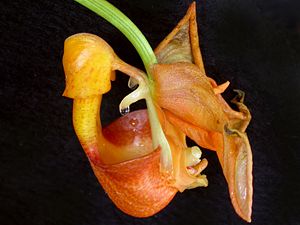
Coryanthes speciosa, flower.
The labellum of the flowers of Coryanthes form a pouch half filled with the liquid that continuously drops from special structures. Insects come to collect it, fall into the pouch and have to exit through a narrow opening below the column, taking the pollinia away with them. This opening is on the right lateral of the labellum on the photograph.
Because of their reproductive structure, orchids need the help of external agents to carry the pollen to the female organ of their flowers; the pollinia are too heavy to be carried by the wind, and the receptive segment of their female organs are not sufficiently exposed to receive it. The orchids are pollinated by agents as diverse as bees, butterflies, diurnal and nocturnal moths, beetles and hummingbirds.[13]
The flowers of most other plants attract pollinators by offering rewards, mostly in form of food. Orchids, being plants that live from so sparse resources, need to be very economical, and they have evolved other techniques of attraction. Their most usual trick is to mimic some form that may interest the insects and other agents, such as color, fragrances, or wax. They have also evolved shapes adapted to ensure that the pollinators carry the pollen when they visit the flowers. They are adapted so perfectly that only the right visitor fits the flower mechanics; other visitors will not take the pollen away. This is because all pollen is aggregated in masses that can only been taken once, so each flower has just one chance of pollination. The labellum also helps a great deal on the process because they developed a variety of structures aiming to place the pollinator on the exact position to ensure that the pollinia they carry will reach the right spot into the flower stigma.[13]
Orchids use the most fascinating strategies to promote pollination. Some of their flowers have extraordinary shapes. Orchids classified under the European genus Orchis show the labellum color and format, ornamented by bristles in such a way that exactly reproduce the females of a particular species of bee, moreover they produce the same pheromone she does, thus the male bees are attracted to a copula, taking then the pollinia with them, which will be delivered to the next visited flower.[27]
Orchids of the African genus Angraecum have white or light green flowers, allowing them to be most seen at night. These flowers produce nectar in extremely long tubes located at the base of their lips, in a way that only certain night moths bearing equally long proboscids may reach it. When they look for the right position, the moths touch their heads on the anthers, and the pollinia become firmly attached to them.[28]
Orchid flowers of the genus Coryanthes, continuously shed a liquid that falls into a bowl formed by their lips. Trying to collect this liquid, the insects fall inside the lip and they just can exit through a tight opening. When passing through it they take the pollinia away on their backs.[29]
The labellum of the flowers of Bulbophyllum species are hinged do the column by a so delicate structure that it allows their lips to balance with the wind in a mimicry of the insects movement.[30]
The flowers of genus Catasetum may be male, female or hermaphrodite. The male flowers are much more attractive than the female ones and have two highly sensitive antennas close to the labellum. When these antennas are touched, they eject the pollinarium so strongly that, if they do not reach the insect, they cover almost two meters in a fraction of a second.[29]
Some orchids secrete fragrances instead of nectar, and some of these fragrances also fake fragrances of other species trying to make the insects to believe they will he rewarded by the orchids as they are by the other plants. This is why the perfume of coconut is the one of Maxillariella tenuifolia, Epidendrum rondoniense smells exactly as red berries, Christensonella subulata is like watermelon and so forth. On the other hand some orchids try to attract a completely different type of insects so they smell like dead meat. Some have different fragrances during the morning and during the night. Some are perfumed just at certain times of the days when the right insects are active.[31] The orchid, Dendrobium sinense, achieves pollination by emitting a pheromone that deceptively informs a hornet, Vespa bicolor, of the presence of its prey.[32]
Some orchid species are easily self pollinated, a process called cleistogamy.[33] Examples of pollination strategies employed by orchids are countless. Other pollination mechanisms will be discussed along the orchid species and genera articles.
Evolution

Microchilus arietinus, flower frontal view.
This genus possibly is one of the most closely related to the extinct Meliorchis caribea, which is the only orchid fossil ever found.
Until recently, it was far from clear when orchids diverged from the ancestrals they share with the other Asparagales, however since the discovery of an early fossil in the Dominican Republic in 2007, it seems that this probably occurred about 84 million years ago. The fossil is from a terrestrial species very similar to species that today are classified under the genus Microchilus. However the exact appearance of the flower is just implied, as only their pollinia were found, attached to the back of a bee trapped in amber.[34]
The pantropical distribution of some primitive genera such as Corymborkis and Vanilla seems to indicate that this occurred before the continents were enterely separated. However, the most active evolution of orchids seems to have occurred after this separation, when the several tropical areas where already well established, about 55 million years ago. It is accepted also that, by this time, the five orchid subfamilies were already separated and their ancestral species well developed.[35]
The epiphytism of orchids is a result of their adjustment to the environmental conditions present along their evolution and is not in itself an ancestral characteristic. The development of vellamen, reduction of the seeds size allowing them to be spread by the wind, and their association to Mycorrhiza should have occurred at the same time they migrated from the soil to the trees. Several characteristics modern orchids share seem to indicate that their primitive ancestor may have been a small plant of sympodial growth, delicate rhyzome, fleshy roots, folded leaves and terminal inflorescences.[36] Their flowers evolved from a lilly type of flower, slowly adapting to their pollinators, getting rid of superfluous structures and adding structural elements to ease pollination by particular agents. The inferior petal, because this was the 'landing track' for the insects, became progressively different from the other two petals, and more and more attractive.[36]
Orchids and Man
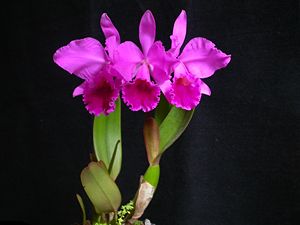
Cattleya labiata var. rubra 'Schuller
When the first Cattleya plants arrived in Europe they were a sensation. This particular clone, besides being a dark variety, was awarded by American Orchid Society for its round and perfect flowers, qualities hardly found in color varieties.
Orchids have fascinated Man for more than 25 centuries. In the past they have been used for healing, as aphrodisiacs, for decoration, and have been associated with superstitions.[37] The Chinese philosopher Confucius is often said to have had a close interest in orchids, although most mentions, where he remarks the properties of their fragrances to which he attributed the character Lán — meaning beauty, softness, love, purity and elegance — come from texts published by his followers. There is one reference to orchids in The School Sayings of Confucius, but even this may be an apocryphal text. Nevertheless, the fact that his followers attributed to Confucius the many diverse citations about these plants only confirms the interest they aroused at the time. China has a long history of appreciation for these flowers. Orchids occur in ancient Chinese literature and in Chinese art since the 10th century BCE; paintings dated to the early Song Dynasty (960–1127), have survived to the present day. Yet, recent investigations have revealed that the culture of Cymbidium started just at the end of Tang Dynasty, between 860 and 890, and not at Confucius time as it was previously believed. Perhaps the first publication exclusively about orchids is a monograph about their extensive culture at the end of the Song Dynasty, between 1128 and 1283. From this work it is clear that their culture was well established in China at the time.[38]
In Europe there are registers from the Greek Classical Period of Theophrastus of Lesbos, at about 300 BCE. In Historia Plantarum, volume 9, he describes a plant with two little buried tubers which he refers to as Orchis, corresponding to the word testicles, possibly a specimen of Anacamptis morio.
Before the Spanish conquered Mexico, the Tlilxochitl fruit, a species of Vanilla, was the most cherished of Aztec spices. This people also praised the Coatzontecomaxochitl, Stanhopea, as sacred flowers which they cultivated in their gardens.[39] The Aztecs also used some orchid species for glue production.[40] After the 16th century, several works were published in Europe: Leonhart Fuchs in Historia Stirpium (1542), Hieronymus Bock in his Annotations volume 2 (1546), Jacques Daléchamps in Historia Generalis Plantarum (1586). After the publication of Species Plantarum by Linné in 1753, publications dealing with orchids became increasingly common.
Before the introduction of exotic species in Europe, orchids were cultivated as garden plants for a long time. The first exotic orchid taken to Europe was a specimen of Brassavola nodosa which arrived in the Netherlands in 1615. In 1688, the first Disa uniflora was brought from South Africa.[8]
Several important collections were gathered in England during the 19th century. In 1818, the first plants of Cattleya labiata, from Brazil, were delivered, causing great sensation and boosting even more the interest in tropical species of orchids.[41]
The advent of their first showy hybrids, at the end of 19th century, slowed down for some decades the interest for new plants from the tropics. Scientific interest in describing new species revived at the start of the 20th century, and plants were collected again in large numbers to be sent to Europe, mostly to botanical gardens and to amateurs with private collections.
The availability of hybrids is increasing constantly, and techniques of seedling have developed so much that prices, once considered expensive, are falling. The artificial reproduction of plants selects those best adapted to different climates, thus species that were once hard to grow outside the wild are becoming easier to grow at home. The generation of once rare wild varieties of natural species, with selected colors and shapes, has made it comparatively easy for anyone to afford plants once available only to the very rich. In a few years, any desirable plant can be produced in thousands. For example, in 2002, Phragmipedium kovachii was an extremely rare species, with only few, recently discovered plants in existence; by 2008 it was common in private collections around the world.
Uses
Despite the vast number of orchid species, few are grown for their utility. Apart from Vanilla, which is widely used as flavoring, fragrant species of Jumellea are used to flavor tea in Africa, and Vanilla is also locally used with tobacco. In Turkey, the tubers of Anacamptis morio are a component of an ice cream called salep. In the 19th century Cyrtopodium pseudobulbs were used as home made glue in Brazil.[42] The true value of orchids today comes from cut flower production, mostly hybrids of the genera Phalaenopsis, Cattleya, Dendrobium, Paphiopedilum and Cymbidium. The same plants are also sold for house decoration.
There are reports of the use of Scaphyglottis species by popular medicine as pain relievers. In 2007, it was reported that extracts of Scaphyglottis livida, had antinociceptive and anti-inflammatory properties in mice.[43]
Thailand has been working on development of extensive production of orchid flowers as export goods to large cities around the world.[44] In 2001, they exported more than 3 million plants, sold for about $40 million.[45] The Agriculture department of Thailand recognized the potential of this culture and is working to increase the quality and attractiveness of their clones granting certificates to the best producers.[46]
In the Netherlands, 216 registered growers produce hybrids for wholesale. In the United States of America it is estimated that, in 2003, the market for potted plants was worth about $121 million. Today the wholesale market is supplied mostly by seedling flasks to be locally cultivated for future sales. From 1991 to 2001, German production of micropropagated orchids rose from two and a half million to twelve million plants, mostly hybrids, particularly of Phalaenopsis.
Culture
Because orchid species are so diverse and come from such varied environments and climates, it is impossible to give universal directions for culturing them. The first step in culturing an orchid is to identify the species. Perhaps the most useful advice to newbies who want to grow orchids is to never buy an orchid without an identification tag, unless it is just for home decoration. The identification tag is the best, and sometimes the only, way to learn how to grow each one of them. If an orchid belongs to a natural species, it is always possible to identify it. Some ways to do so are asking more experienced orchid collectors, looking the species up in books or on the internet, or even joining orchid societies. Learning the name of the species means learning where it comes from, so their original natural conditions may be reproduced, deciding what is the best amount of light, humidity, temperature or watering, which is the best type of substrate and drainage, if they should be potted or mounted, and what is the resting period regime of the plant. The most common error is potting orchids on mud. Few orchids will thrive on this, as most are epiphytes, and need their roots to be dry again soon after having been watered. There is no mud over the trees where they live. There are many choices of substrate mixes available on stores. Another common mistake is having a plate under the pots; plates result in excess humidity and unless this orchid is one of the few that likes humidity, it will be dead in a few months.
Orchids are often thought to be delicate plants that are hard to grow. This is not true. Orchids can withstand a lot of adverse conditions and sometimes they even need them. It is interesting to notice how some orchids, when well cared for, grow beautifully but never bloom. This is the case with several species of Dendrobium which need a very dry period at the end of their resting time. During this, their pseudobulbs shrink and the plant assumes a very poor appearance, sometimes losing all its leaves. This seems to indicate that the plant feeling the adversity gathers all its strength and blooms trying to spread their seed before dying. However, just after they bloom, it is rain time in the wild so they start to receive all the nutrients they need to live through another cycle. Some species from South Africa, including Disa, can go several years without blooming, but if there is a fire in the area they bloom generously. Other plants need extreme cold to trigger the blooming, or just a very hot day with a cold shower at the end. The pseudobulbs of most orchids make them very resistant, able to pass a long time without being potted. Some growers never pot or mount their orchids. Most monopodial orchids from southeast Asia can live with all their roots just hanging in the air. In nature, they take their nutrients from the water that washes the tree leaves above them, in nurseries, they take them from fertilizers. Orchid hybrids usually are stronger than wild orchids, for they have mixed genes from two species and this generally produces stronger individuals, which grow faster than wild species.
Almost every large city in the world has at least one orchid society where local amateur and professional growers congregate. These societies have regular meetings, sometimes weekly, sometimes monthly, where they discuss the latest news, exchange experiences and orchids, show plants, learn to recognize what is desirable in a plant, listen to lectures and even visit for partying. When there are several societies in other cities nearby, they may have orchid shows open to the public and organize championships of culture and rarity. Most countries have a main institution responsible for the schedule of orchid shows, for setting their rules and managing the evaluating and judges selection, and keeping the records of best orchids shown. Two examples of such organizations are the American Orchid Society, AOS, and Coordenadoria das Associações Orquidófilas do Brasil, CAOB. Both are non-profit institutions which keep dedicated websites and are very good references for those looking for information about the orchid societies in their area.
Growing orchids in the north of the U.S.A. or in Europe is much harder than in tropical areas. Expenses to maintain small greenhouses or nurseries may be high during the winter and growers in those areas usually would rather grow smaller species so they can have more varieties in less room. Growers in tropical areas hardly have to concern themselves with the weather conditions, such that large species are more affordable and more common in those collections. Orchid culture is very popular in the southeast of Brazil. There are so many orchid societies in São Paulo State that every weekend there is at least one orchid show, and sometimes four at once, spread through the cities in the region.[47] Attending those societies' gatherings and orchid shows is the best way to learn about orchid culture.
Production
The easiest way of obtaining a second plant from an orchid, and the most commonly used by private collectors and small professional growers, is by dividing the rhyzome or the stem. This can be done with almost any adult plant that has at least six pseudobulbs in line. In this case, the rhyzome is divided and the grower has two plants with three pseudobulbs each. The best time for doing this is when the plant is shooting new roots. This method is not suitable for large scale production because, as a rule, orchids produce just one or two pseudobulbs each year. However, orchids can also be mass-produced thanks to the fantastic amount of seeds each fruit bears and to the development of the seedlings by micropropagation.[48]
The advantages of reproducing plants from seeds, called sexual reproduction, are several. It raises the genetic diversity of the species and naturally selects the strongest and most viable plants. To some extent, it also helps in the cultivation of certain notoriously-hard-to-grow orchids in climates that are slightly different than their places of origin, because the seeds that grow faster are the ones more suited to the new place. An additional advantage of sexual reproduction is that, among so many different plants produced, some special varieties may appear.
As orchid seeds have almost no endosperm, they need very particular conditions to germinate. In nature this is provided mostly when the seed falls close to other existing orchids. Mycorrhizas are ubiquitous in orchid roots where they support the seedling's nutritional demands. Before the development of artificial methods of providing the conditions needed by the seedlings, for many decades, growers tried several home recipes of culture media based on tomatoes, bananas and many other ingredients cooked with agar and placed in sterile flasks with fresh smashed tips of orchid roots to add the fungus. The time an orchid takes to develop from the seed to a blooming size plant varies according to the genus, but is seldom less than three years and is usually five or six years.[48]
Rare species and varieties can also be propagated by their meristem, (the tissue of undifferentiated cells found in zones of the plant where growth can take place, particularly gems from the stem and root apex, which can be compared to stem cells in animals). This tissue is cultivated under appropriate conditions sometimes adding hormones, and progressively cut several times. The process is repeated until the number of desired clones is achieved. All plants obtained from meristem are genetically identical to the mother plant, so this is a type of vegetative reproduction.[49]
Most popular genera
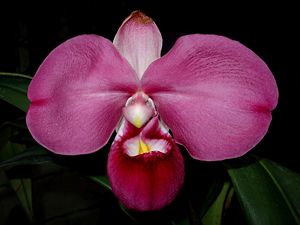
Phragmipedium kovachii
This rare and fascinating species was first discovered when few plants were found growing over remote stone ravines in Peru, in 2002. It has been reproduced by the thousands and is already becoming common in orchid collections.
As mentioned above, orchid culture conditions vary throughout the world, both because different genera are adapted to different environments, and because of the different climatic environments under which they are cultured at present. Therefore, the most-cultured species in one area or country may be very rare at different places, and virtually unknown to growers there. For instance, Odontoglossum and Masdevallia from high altitudes in the Andes are almost impossible to grow in Brazil, where the nurseries are mostly open and subject to the weather conditions. Some of these plants prefer high luminosity, which cannot easily be provided without high temperature in places like Brazil. On the other hand, in the Northern U.S.A. these conditions are much easier to provide although growers there will find it very difficult to keep species from the Amazon, like Acacallis, in constant high temperature and humidity throughout the year. Moreover, genera mostly grown in different areas of the globe vary because not all species are easily available in every place.
Despite these obstacles, orchid collectors always keep trying to grow the species they like, and some orchid genera and species tend to be part of almost all collections. Ahead is a short list of the most noted and cultivated orchid genera.[47] The list is organized by continent of origin, not culture, and some orchids may not be grown in particular areas thus their popularity varies from country to country.
- Europe: Orchis, Ophrys, Cypripedium.
- Asia and Oceania: Cymbidium, Dendrobium, Phalaenopsis, Paphiopedilum, Vanda, Bulbophyllum, Coelogyne, Dendrochilum, Eria.
- Africa: Angraecum, Aerangis, Disa.
- America: Cattleya, Laelia, Oncidium, Epidendrum, Brassia, Catasetum, Sophronitis, Miltonia, Pleurothallis, Masdevallia, Lycaste, Maxillaria, Phragmipedium, Encyclia, Odontoglossum, Brassavola.
Hybrids

Fancy orchid hybrid
This plant has a very long name. When this photo was taken it was not registered, so it was tagged as "the crossing of Sophrolaeliocattleya Orchidglade 'Early Harvest' with Laeliocattleya Chocotone Gold". Few orchids have common names and if they do, these are mostly used locally. Orchid societies do not allow them, for they vary too much and are not regulated. Orchid collectors and their producers just use scientific names.
The artificial production of orchid hybrids began more than a hundred years ago, with the first hybrid being made in 1854. Fertile orchid hybrids can be crossed with other species of the same or different genera and produce new generations of fertile hybrids. Growers greatly value this promiscuity because it allows them to endlessly produce new combinations of color and pattern. Today, some hybrids are formed from up to twenty distinct species from as many as nine different genera, and the future is likely to hold even more wildly crossed examples.
Although the Royal Horticultural Society (RHS), along with The International Orchid Register, attempt to maintain detailed records of all existing orchid hybrids, their records are very incomplete due to many decades of unrecorded hybridization by local growers. Many hybrids were produced before knowledge of the RHS became widespread among local growers, and even now, many choose not to register their crosses. The current estimate is that there are more than a hundred thousand hybrids, but the exact number of man-made hybrids will always remain a guess. Over three thousand new hybrids are being added annually.
According to the rules of the International Code of Nomenclature for Cultivated Plants (ICNCP), hybrids of species belonging to the same genus always take this genus name, for instance, the result of breeding two Cattleya remains a Cattleya. When two genera are used, a new genus name is created with parts of each original ones, for instance, the hybrid of a Laelia and a Cattleya is a Laeliocattleya. When three or more genera are involved, the producer may choose any name he wishes for the resulting genera, provided he follows a few rules regarding names suffixes and that no other name had been previously registered for the same genera crossing.
References
- ↑ Jump up to: 1.0 1.1 1.2 1.3 1.4 1.5 Hoehne FC (1940) Flora Brasílica Fascículo 1, Volume 12.1; 1 a 12 - Orchidaceae, introdução.
- ↑ Jump up to: 2.0 2.1 Dressler RL (1981). The Orchids: Natural History and Classification. Harvard University Press. ISBN 0674875257.
- ↑ Jump up to: 3.0 3.1 Atwood JT (1986) The size of the Orchidaceae and the systematic distribution of epiphytic orchids. Selbyana 9:171-86.
- ↑ Pabst G, Dungs F (1975) Orchidaceae Brasilienses vol. 1, Brucke-Verlag Kurt Schmersow, Hildesheim. ISBN 3871050106
- ↑ Jump up to: 5.0 5.1 5.2 Govaerts R, Campacci MA(Brazil, 2005), Holland Baptista D (Brazil, 2005), Cribb P (K, 2003), George A (K, 2003), Kreuz K (2004, Europe), Wood J (K, 2003, Europe) World Checklist of Orchidaceae. The Board of Trustees of the Royal Botanic Gardens, Kew. Checklists by region and Botanical countries.Published on Internet access 1st March 2009.
- ↑ Jump up to: 6.0 6.1 6.2 6.3 Govaerts R et al. World Checklist of Orchidaceae. The Board of Trustees of the Royal Botanic Gardens, Kew. Published on Internet access 1st March 2009.
- ↑ Hoffman N, Brown A (1998) Orchids of South-west Australia. University of Western Australia Press, Nedlands.Rev. 2nd ed. with suppl. ISBN 1876268182
- ↑ Jump up to: 8.0 8.1 Wodrich KHK, Balkema AA (1997). Growing South African Indigenous Orchids. ISBN 978-9054106500.
- ↑ Averyanov L et al.' (2003) Slipper Orchids of Vietnam. Timber Press, Portland, Oregon. ISBN 0881925926
- ↑ Hansen E (2000) Orchid Fever. Methuen. ISBN 0413747506.
- ↑ Jump up to: 11.0 11.1 Chan CL (1994). The species concept, pp. 27 in Orchids Of Borneo. The Sabah Society and Kew: Bentham-Moxon Trust, Volume 1. ISBN 967 9994732
- ↑ Jump up to: 12.00 12.01 12.02 12.03 12.04 12.05 12.06 12.07 12.08 12.09 12.10 12.11 Phillip Cribb (2001) Morphology of Orchidaceae. Pridgeon AM, Cribb PJ, Chase MW, Rasmussen FN eds., Genera Orchidacearum vol. 1. Oxford University Press, Oxford, UK ISBN 0198505132.
- ↑ Jump up to: 13.0 13.1 13.2 13.3 13.4 13.5 13.6 13.7 Joseph Arditti (1992) Fundamentals of Orchid Biology. Wiley & Sons. ISBN 9780471549062.
- ↑ Selbyana, 18(2): 172-182, 1997
- ↑ Harding PA (2008) Huntleyas and Related Orchids Timber Press. ISBN 9780881928846.
- ↑ Selbyana, 18(2): 172-182, 1997
- ↑ Yohan Pillon e Mark W.Chase. (2006). Taxonomic Exaggeration and its Effects on Orchid Conservation. Conservation Biology 21:263-5.
- ↑ Jump up to: 18.0 18.1 Antonii Laurentii de Jussieu (1789). Genera plantarum: secundum ordines naturales disposita, juxta methodum in Horto regio parisiensi exaratam, anno M.DCC.LXXIV. Parisiis: apud viduam Herissant et Theophilum Barrois.
- ↑ Caroli Linnaei (1753). Species plantarum: exhibentes plantas rite cognitas, ad genera relatas, cum differentiis specificis, nominibus trivialibus, synonymis selectis, locis natalibus, secundum systema sexuale digestas... Holmiae: Impensis Laurentii Salvii.
- ↑ Pedáneo Dioscórides (50-70 CE). De materia medica.
- ↑ Phillip Cribb (2001) Orchidaceae. Em AM, Pridgeon, Cribb PJ, Chase MW, and Rasmussen FN eds., Genera Orchidacearum vol. 1. Oxford University Press, Oxford, UK ISBN 0198505132.
- ↑ Clements MA, Jones DL(2002). Nomenclatural changes in the Dendrobieae (Orchidaceae) 1: The Australasian region. Orchadian 13:485-97.
- ↑ Mark W. Chase (2001) Molecular Systematics, Parcimony and Orchid Classification. Em AM Pridgeon, Cribb PJ, Chase MW, and Rasmussen FN eds., Genera Orchidacearum, vol. 1: pp.83. Oxford University Press, Oxford, UK ISBN 0198505132.
- ↑ Carlyle August Luer (2004). Icones Pleurothallidinarum, Volume XXVI, A Second Century of New Species of Stelis of Ecuador. pp.253. Missouri Botanical Garden. ISBN 1930723292
- ↑ de Queiroz, K. (2005). Ernst Mayr and the modern concept of species in PNAS USA 102 Suppl.1 6600–7 pmid=15851674
- ↑ Menezes LC Cattleya × mesquitae in Boletim CAOB 26:24. São Paulo, 1996.
- ↑ Borg-Karlson, A.K. (1990) Chemical and ethological studies of pollination in the genus (Ophrys) (Orchidaceae). Phytochemistry 29: 1359-87.
- ↑ Joyce Stewart, Johan Hermans e Bob Campbell (2006) Angraecoid Orchids: Species from the African Region. Timber Press, Incorporated. ISBN 9780881927887.
- ↑ Jump up to: 29.0 29.1 Hermann Crüger (1865). A few notes on the fecundation of orchids and their morphology. J Linn Soc Lond (Bot.) 8:127–35.
- ↑ Emly S. Siegerist (2001) Bulbophyllums and Their Allies: A Grower's Guide. Publisher: Timber Press. ISBN 9780881925067.
- ↑ Flach A et al. (2004) The chemistry of pollination in selected Brazilian Maxillariinae orchids: floral rewards and fragrance. J Chem Ecol 30:1039-50
- ↑ Brodmann J, Twele R, Francke W, Yi-bo L, Xi-qiang S, Ayasse M. (2009) Orchid Mimics Honey Bee Alarm Pheromone in Order to Attract Hornets for Pollination. Current Biology 19:1368-72.
- ↑ Brieger & Illg (1977) Maxillaria cleistogama em Trab Congr Nac Bot 26:247.
- ↑ Santiago R et al. (2007) Dating the origin of the Orchidaceae from a fossil orchid with its pollinator. Nature 448:1042-5
- ↑ Brieger FG (1969) Patterns of evolutionary and geographical distribution in neotropical orchids. Biol J Linn Soc 1:197-217. Universidade de Campinas.
- ↑ Jump up to: 36.0 36.1 Burns-Balogh P et al. (1985) Evolution of the monandraceous Orchidaceae VI. Evolution and pollination mechanisms in the subfamily Orchidoidea. Can Orchid J 3:29-57.
- ↑ Lawler L. 1984. Ethnobotany of the Orchidaceae in Orchid Biology: reviews and perspectives Vol. 3 - Cornell University Press.
- ↑ Sing-Chi CHEN e Yi-Bo LUO. (2008). A Retrospect and Prospect of Orchidology in China, J Integr Plant Biol 45(Suppl.). Botanical Society of China.
- ↑ Carlos Ossenbach. 2005. History of Orchids in Central America, part 1: from prehispanic times to the independence of the new republics, Harvard Papers in Botany' 183–226
- ↑ Hernández F 1959. Historia Natural de Nueva España. 2 vols. Mexico City: Universidad Nacional de Mexico.
- ↑ Brian Williams & Jack Kramer (1980) Orchids for everyone: a practical guide to the home cultivation of over 200 of the world's most beautiful varieties. Salamander. ISBN 0701814969
- ↑ Hoehne, Frederico Carlos (1940) Flora Brasílica, Fascículo 1, Volume 12.1; 1 a 12 - Orchidaceae, introdução.
- ↑ Déciga-Campos M et al. (2007) Antinociceptive and anti-inflammatory effects of compounds isolated from Scaphyglottis livida and Maxillaria densa. J Ethnopharmacol 114:161-8
- ↑ Oradee Sahavacharin - Cut Flower Production in Thailand. 1998. Food and Agriculture Organization (FAO) of the United Nations - Regional Office for Asia and the Pacific, Bangkok, Thailand, Published on Internet.
- ↑ C Piluek & Lamseejan S - (2002) Orchid Improvement through Mutation Induction by Gamma rays. Published on Internet.
- ↑ Thailand official news and information news - Promoting the Efficiency of Orchid Production to Increase Exports 2nd October 2008. Published on Internet.
- ↑ Jump up to: 47.0 47.1 Coordenadoria das Associações Orquidófilas do Brasil (2008) Orchid shows records.
- ↑ Jump up to: 48.0 48.1 Waldemar Silva (1976) Cultivo de Orquídeas no Brasil. Nobel. ISBN 8521303831.
- ↑ Arditti J, Ernst R (1993) Micropropagation of Orchids. John Wiley & Sons. ISBN 9780471549055
- Pages using ISBN magic links
- Editable Main Articles with Citable Versions
- CZ Live
- Biology Workgroup
- Agriculture Workgroup
- Hobbies Workgroup
- Botany Subgroup
- Articles written in British English
- Advanced Articles written in British English
- All Content
- Biology Content
- Agriculture Content
- Hobbies Content
- Hobbies tag
- Botany tag
